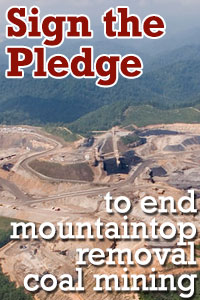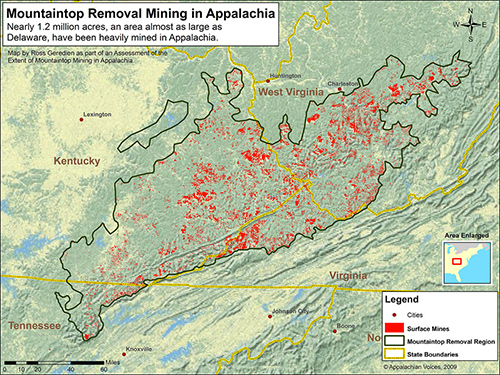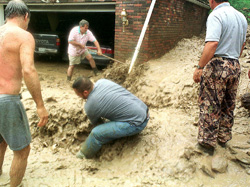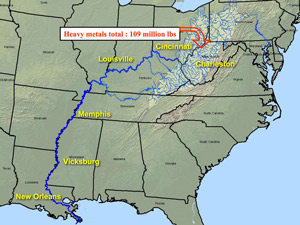What is mountaintop removal coal mining?

Mountaintop removal is a relatively new type of coal mining that began in Appalachia in the 1970s as an extension of conventional strip mining techniques. Primarily, mountaintop removal is occurring in West Virginia, Kentucky, Virginia and Tennessee. Coal companies in Appalachia are increasingly using this method because it allows for almost complete recovery of coal seams while reducing the number of workers required to a fraction of what conventional methods require.
The US Environmental Protection Agency defines mountaintop removal as follows:
“Mountaintop removal/valley fill is a mining practice where the tops of mountains are removed, exposing the seams of coal. Mountaintop removal can involve removing 500 feet or more of the summit to get at buried seams of coal. The earth from the mountaintop is then dumped in the neighboring valleys.”
There are 6 main components of the mountaintop removal process:
CLEARING
Before mining can begin, all topsoil and vegetation must be removed. Because coal companies frequently are responding to short-term fluctuations in the price of coal, the trees are often not used commercially, but instead are burned or sometimes illegally dumped into valleys.
BLASTING
Many Appalachian coal seams lie deep beneath the surface of the mountains. Accessing these seams can require the removal of 600 feet or more of elevation. Blowing up this much mountain is accomplished by using millions of pounds of explosives.
DIGGING
Coal and debris are removed using enormous earth-moving machines known as draglines, which stand 22 stories high and can hold 24 compact cars their buckets. These machines can cost up to $100 million, but are favored by coal companies because they displace the need for hundreds of miners.
DUMPING WASTE
In 2002, the Bush Administration changed the definition of “fill material” in the Clean Water Act to include toxic mining waste, which allowed coal companies to legally dump the debris, called “overburden” or “spoil,” into nearby valleys. These “valley fills” have buried more than 2,000 miles of headwater streams and polluted many more.
PROCESSING
Coal must be chemically treated before it is shipped to power plants for burning. This processing creates coal slurry, or sludge, a mix of water, coal dust and clay containing toxic heavy metals such as arsenic, mercury, lead and chromium. The coal slurry is often dumped in open impoundments, sometimes built with mining debris, making them very unstable.
RECLAMATION
While reclamation efforts are required by federal law, coal companies often receive waivers from state agencies with the idea that economic development will occur on the newly flattened land. In reality, most sites receive little more than a spraying of exotic grass seed, and less than 3 percent of reclaimed mountaintop removal sites are used for economic development. According to a U.S. Environmental Protection Agency impact statement on mountaintop removal in Appalachia, it may take hundreds of years for a forest to re-establish itself on the mine site.
Where is mountaintop removal happening?
Mountaintop removal takes place primarily in eastern Kentucky, southern West Virginia, southwestern Virginia, and eastern Tennessee.
A study in 2009 showed that nearly 1.2 million acres to date had been surface mined for coal, and more than 500 mountains destroyed by mountaintop removal coal mining. In some counties, such as Wise County, Va., surface mining has impacted nearly 40 percent of the land area.
| Kentucky | 574,000 acres | 293 mountains |
| Tennessee | 78,000 acres | 6 mountains |
| Virginia | 156,000 acres | 67 mountains |
| West Virginia | 352,000 acres | 135 mountains |
| TOTAL | 1,160,000 acres | 501 mountains |
What are the effects of mountaintop removal on families and communities?
Even government agencies that regulate mountaintop removal agree that the effects on nearby homes and communities can be devastating. In their Mid-Atlantic Regional Assessment, the Environmental Protection Agency states:
“The impact of mountaintop removal on nearby communities is devastating. Dynamite blasts needed to splinter rock strata are so strong they crack the foundations and walls of houses. Mining dries up an average of 100 wells a year and contaminates water in others. In many coalfield communities, the purity and availability of drinking water are keen concerns.”
In addition to the frequent loss or pollution of drinking water, families living near mountaintop removal sites contend with:
FLOODING
Coalfield residents have long complained about drastic increases in flooding following mountaintop removal operations. The coal industry maintains such floods are “Acts of God.” Researchers at the university of Kentucky recently concluded: “there is a clear risk of increased flooding (greater runoff production and less surface flow detention) following [mountaintop removal and valley fill] operations.”
BLASTING
Families and communities near mountaintop removal sites are forced to contend with continual blasting from mining operations that can take place up to 300 feet from their homes and operate 24 hours a day. The impact of blasting not only makes life all but unlivable in nearby homes, it also frequently cracks wells and foundations. Blasting can send boulders flying hundreds of yards into roads and homes.
SLUDGE DAM
Sludge dams represent the greatest threat to nearby communities of any of the impacts of coal mining. Impoundments are notoriously leaky, contaminating drinking water supplies in many communities, and are also known to fail completely. A sludge dam breach in Martin County, KY, in 2000, sent more than 300 million gallons of toxic coal sludge into tributaries of the Big Sandy, causing what the EPA called, “The biggest environmental disaster ever east of the Mississippi.”
How does mountaintop removal affect the environment?
Mountaintop Removal is occurring right at the heart of one of the nation’s main hotspots of biological diversity. According to the Nature Conservancy, the mountain region including southwest Virginia, southern West Virginia, eastern Kentucky and northeastern Tennessee contains some of the highest levels of biological diversity in the nation. This region is also at the headwaters of the drinking water supplies of many US cities. The maps below show hotspots of biodiversity based on a rarity-weighted index biological diversity produced by the Nature Conservancy, as well as the major river systems with headwaters in the Appalachian coalfields.
Unfortunately, there is little information on the cumulative impacts of mountaintop removal because the federal agencies that are charged with regulating coal mining have refused to track the overall extent and impacts of mountaintop removal. The one attempt at a comprehensive analysis of MTR by government agencies was presented in a multi-agency Environmental Impact Statement that was completed in 2003. This effort was initiated in the late 90s, but the focus of the EIS was revised after the White House changed hands in 2001. According to the Charleston Gazette:
“When it formally kicked off the project in February 1999, the EPA said the goal was “to consider developing agency policies … to minimize, to the maximum extent practicable the adverse environmental effects” of mountaintop removal. By October 2001, then-Deputy Interior Secretary Steven J. Griles, a former mining industry lobbyist, had ordered the project refocused toward “centralizing and streamlining coal mine permitting.”
Cindy Tibbot, a FWS biologist involved in the EIS process, was one of many agency scientists who expressed outrage about Griles’ directive, stating in an internal memo: “It’s hard to stay quiet about this when I really believe we’re doing the public and the heart of the Clean Water Act a great disservice.”
As Tibbot put it, the only alternatives offered in Griles’ proposed EIS would be “alternative locations to house the rubber stamp that issues the [mining] permits.”
While the EIS did compile a lot of disparate information on the effects and extent of MTR, the analysis was based on mining permit maps. According to satellite analysis done by Michael Shank at the TAGIS center of the West Virginia DEP, however, those permit maps are underestimating the extent of valley fill in 6 West Virginia coal counties by about 40%. Thus, the entire EIS is based on verifiably faulty data.
Despite its many flaws, however, the multi-agency environmental impact statement did provide some useful information on the extent and impacts of mountaintop removal. Here are some of the impacts and concerns expressed in the final EPA report:
- More than 7 percent of Appalachian forests have been cut down and more than 1,200 miles of streams across the region have been buried or polluted between 1985 and 2001.
- Over 1000 miles of streams have been permitted to be buried in valley fills. (for scale, this is a greater distance than the length of the entire Ohio River).
- Mountaintop removal mining, if it continues unabated, will cause a projected loss of more than 1.4 million acres by the end of the decade-an area the size of Delaware-with a concomitant severe impact on fish, wildlife, and bird species, not to mention a devastating effect on many neighboring communities.
- 800+ square miles of mountains are estimated to be already destroyed. (this is equal to a one-quarter mile wide swath of destruction from New York to San Francisco – it is also significantly underestimated).
Other quotes from the 2003 report include:
- “… studies found that the natural return of forests to mountaintop mines reclaimed with grasses under hay and pasture or wildlife post-mining land uses occurs very slowly. Full reforestation across a large mine site in such cases may not occur for hundreds of years.”
- “Because it is difficult to intercept groundwater flow, it is difficult to reconstruct free flowing streams at mountaintop removal sites.”
- “Stream chemistry monitoring efforts show significant increases in conductivity, hardness, sulfate, and selenium concentrations downstream of [mountaintop removal] operations.”
Where can I learn more about mountaintop removal?
The organizations partnering on this website and our allied organizations have many further resources on the web about mountaintop removal. Click here to see a list of links to those organizations.





















